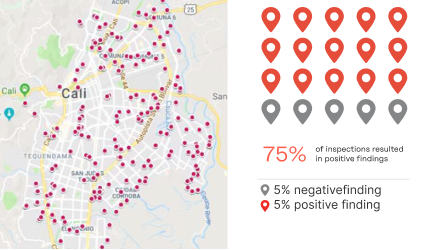Overview
In 2016, Cali, Colombia had the highest number of Zika cases in the country. The city’s public health team decided to fight the outbreak by using a combination of surveillance, control and prevention activities. But the city lacked a robust system for managing field activities in real-time to make datadriven decisions on mosquito abatement and eradication.
The U.S. Agency for International Development (USAID), through a Grand Challenge Grant, asked Premise Data to design a series of tasks local residents could undertake, using their smartphones, as a way to identify Aedes aegypti breeding sites, destroy them and then change the human-led behaviors that were allowing mosquitoes to breed and spread. Premise created real-time dashboards for the city health authorities who manage vector monitoring and control activities. Ultimately this meant decisions could be made practically in real time, and certainly much faster than ever before: Historically disease data would be collected from hospitals, reported to the national surveillance system, and only then given to health authorities, a process that could take a week or more.
Results from the pilot project, which ran from early 2018 until July 2019, suggested that when people were shown mosquito breeding grounds and informed about the Zika virus, they were more likely to inspect their own homes and then take steps to keep them mosquito-free.
More than 7,000 citizens participated in the project, working in three cities in Colombia— Cucuta, Cali and Santa Marta. By the time the project had concluded, some 108,000 home inspections had been completed (some homes were inspected multiple times).
Findings
Local citizens were asked to complete different Zika monitoring tasks. These included walking mapped routes, inspecting public spaces and private homes, asking questions, taking photos and destroying breeding sites. Destroying the breeding ground could consist of efforts such as emptying barrels of non potable water, cleaning up known breeding areas using bleach tablets and discarding old tires (where water tends to pool).
Contributors ultimately completed more than 108,130 tasks and destroyed more than 70,070 positive mosquito breeding sites.

Implications
The tasks were co-designed with local health authorities to train an average citizen to identify and destroy mosquito breeding sites that were found on a regular street, public park or in a house.
The local officials used the data collected to detect and remediate coverage gaps and eventually dispatched workers to the highest-risk areas in real-time. Using Premise’s data visualization dashboards, local health authorities were empowered to make evidence-based decisions using data they previously did not have access to.
By the end of the project, the average number of breeding sites in the areas inspected was reduced by 65%, dropping from 3.5 sites to 1.2 sites. “Softer” data tells us the community network vastly improved its self-regulation.

Participants were paid either in bitcoin or by bank deposit. Premise pays people in a variety of ways, per their preference, including crypto. For “unbanked” populations, and in regions where there is hyperinflation, or where the local currency is worthless, Contributors prefer to be paid in bitcoin. Some people want another currency and there are a number of reasons some Contributors prefer bitcoin. Bitcoin improves access and speed of payment for people in low and moderate income brackets, and also reduces the fees associated with cross-border money transfer.
An Innovative New Participatory Approach
As this project proved, getting local communities involved in collecting data to monitor disease outbreaks can help to complement the work done by health officials who have typically carried out such tasks. It also encourages citizens to recognize they are empowered to help prevent the spread of disease by implementing healthy habits rather than relying on local governments to solve every problem.
Using a vast collection of data points, Premise, USAID and the citizen network were able to show Colombian authorities through mapping where the most high-impact areas were. As regions around the globe face new mosquitoborne outbreaks, there is a growing need to find new ways to monitor and reduce the spread of infectious diseases like Zika and dengue, which includes giving affected communities techbased solutions. The USAID/ Premise project demonstrates one effective option.
